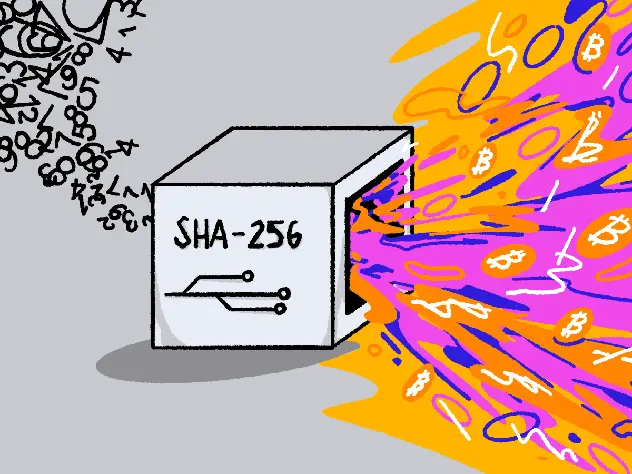Public-key Cryptography
At the heart of Bitcoin’s security lies public-key cryptography, a mathematical technique that enables secure communication and transaction verification. Each user on the Bitcoin network possesses a pair of cryptographic keys: a public key, which serves as their address for receiving funds, and a private key, which remains secret and is used to sign transactions.
When a user initiates a transaction, it is signed with their private key, providing a unique digital signature. This signature, along with the public key, is then verified by the network to ensure the transaction’s authenticity and integrity. The robustness of public-key cryptography prevents unauthorized access and protects against fraudulent transactions.
Proof-of-Work (PoW)
Proof-of-Work is the consensus mechanism that underpins the decentralized nature of Bitcoin. Miners compete to solve computationally intensive mathematical puzzles using their computational power. The first miner to find the solution gets to add the next block to the blockchain and is rewarded with newly minted bitcoins and transaction fees.
The difficulty of the puzzle adjusts regularly to ensure that new blocks are added roughly every ten minutes. This competitive process prevents any single entity from gaining control of the network and ensures the security and integrity of the blockchain.
Halving and Scarcity
Built into the mathematics of Bitcoin is the process of “halving,” which occurs approximately every four years. During a halving event, the number of new bitcoins created as mining rewards is reduced by half. This mechanism enforces the fixed supply of bitcoins and contributes to its inherent scarcity, increasing its value over time.
Hash Functions
Hash functions are another crucial mathematical component of Bitcoin’s security. These one-way mathematical functions convert variable-length data (such as a transaction or a block) into a fixed-length string of characters, known as a hash. The resulting hash is unique to the input data and serves as a digital fingerprint for verification.
In Bitcoin’s blockchain, each block contains a hash of the previous block, creating a chain of blocks where altering any block would require recalculating all subsequent blocks. This property, known as immutability, ensures that the blockchain remains tamper-resistant.
Randomness and Unpredictability
Bitcoin’s security is further strengthened by the element of randomness and unpredictability. For example, the process of mining involves guessing random numbers to find a valid solution to the PoW puzzle. Additionally, the selection of miners to add new blocks is probabilistic, adding a layer of unpredictability to the system.
SHA-256: The Backbone of Bitcoin’s Security
In the world of Bitcoin, SHA-256 (Secure Hash Algorithm 256-bit) plays a critical role in ensuring the security and integrity of the blockchain. SHA-256 is a cryptographic hash function, a mathematical algorithm that takes an input of any size and produces a fixed-size output, known as a hash. Let’s explore how SHA-256 works and its significance in the Bitcoin network.
The Function of SHA-256
SHA-256 takes an input, known as a message, and performs a series of mathematical operations on it to generate a 256-bit (32-byte) output, represented as a hexadecimal number. This output is a unique and fixed-length representation of the input data, often referred to as the “hash value” or “digest.”
Uniqueness and Determinism
One of the key properties of SHA-256 is that it produces a unique hash value for each unique input. Even a tiny change in the input data will result in a drastically different hash. This property is known as the “avalanche effect,” where a small modification in the input produces an entirely different output.
Moreover, SHA-256 is a deterministic function, meaning that for the same input, it will always produce the same hash value. This consistency is essential in verifying the integrity of data and ensuring the accuracy of transactions on the Bitcoin blockchain.
Irreversibility and Immutability
Another crucial characteristic of SHA-256 is its irreversibility. It is practically impossible to derive the original input data from the hash value, making SHA-256 a one-way function. This irreversibility enhances the security of the Bitcoin network, as the original data cannot be deduced from the hashes stored on the blockchain. The immutability of SHA-256 hashes further strengthens the integrity of the blockchain. Once a block is added to the blockchain with its hash included in the subsequent block, changing the data in that block would require recalculating the hash for all subsequent blocks. This process is computationally infeasible due to the immense amount of computational power required, effectively making the blockchain tamper-resistant.
Ridiculous Amount of Numbers
The 256-bit output of SHA-256 results in an astronomical number of possible hash values. To put it into perspective, there are 2^256 (approximately 1.1579 x 10^77) possible hash values. This immense number of possibilities makes it extremely unlikely for two different sets of input data to produce the same hash value, a property known as “collision resistance.” In the context of Bitcoin mining and proof-of-work, miners must find a hash value below a specific target, which is a number with a certain number of leading zeros in its binary representation. Since the output of SHA-256 appears to be random, miners must repeatedly guess different inputs (known as nonces) to find a valid hash that satisfies the required target. This process of finding a valid hash, known as “hashing,” consumes considerable computational power and is a fundamental part of the mining process that secures the Bitcoin network.
Conclusion
In conclusion, the intricate world of Bitcoin’s security is intricately woven with the threads of mathematics. Public-key cryptography ensures the sanctity of transactions, while the Proof-of-Work mechanism maintains decentralization. The concept of halving and the use of hash functions add to its robustness. The unpredictable nature of mining and the unbreakable SHA-256 algorithm further bolster Bitcoin’s security. With its foundation rooted in mathematical principles, Bitcoin stands as a testament to the power of mathematics in the realm of digital currency, offering both security and decentralization to its users.
